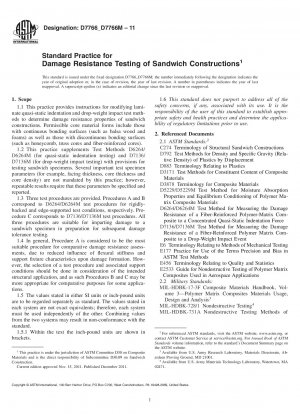ASTM D7766/D7766M-11
Standard Practice for Damage Resistance Testing of Sandwich Constructions
- Standard No.
- ASTM D7766/D7766M-11
- Release Date
- 2011
- Published By
- American Society for Testing and Materials (ASTM)
- Status
- Replace By
- ASTM D7766/D7766M-16
- Latest
- ASTM D7766/D7766M-23
- Scope
This practice provides supplemental instructions that allow Test Methods D6264/D6264M (for quasi-static indentation testing) and D7136/D7136M (for drop-weight impact testing) to determine damage resistance properties of sandwich constructions. Susceptibility to damage from concentrated out-of-plane forces is one of the major design concerns of many structures made using sandwich constructions. Knowledge of the damage resistance properties of a sandwich panel is useful for product development and material selection.
Sandwich damage resistance testing can serve the following purposes:
To establish quantitatively the effects of facing geometry, facing stacking sequence, facing-to-core interface, core geometry (cell size, cell wall thickness, core thickness, etc.), core density, core strength, processing and environmental variables on the damage resistance of a particular sandwich panel to a concentrated quasi-static indentation force, drop-weight impact force, or impact energy.
To compare quantitatively the relative values of the damage resistance parameters for sandwich constructions with different facing, core or adhesive materials. The damage response parameters can include dent depth, damage dimensions and location(s), indentation or impact force magnitudes, impact energy magnitudes, as well as the force versus time curve.
To impart damage in a specimen for subsequent damage tolerance tests.
Quasi-static indentation tests can also be used to identify a specific sequence of damage events (only the final damage state is identifiable after a drop-weight impact test).
The properties obtained using these practices can provide guidance in regard to the anticipated damage resistance capability of sandwich structures with similar materials, geometry, stacking sequence, and so forth. However, it must be understood that the damage resistance of a sandwich structure is highly dependent upon several factors including geometry, thickness, stiffness, mass, support conditions, and so forth.
Significant differences in the relationships between force/energy and the resultant damage state can result due to differences in these parameters. For example, properties obtained using edge-supported specimens would more likely reflect the damage resistance characteristics of a sandwich panel away from substructure attachments, whereas rigidly-backed specimens would more likely reflect the behavior of a panel local to substructure which resists out-of-plane deformation. Similarly, edge-supported impact test specimen properties would be expected to be similar to those of a sandwich panel with equivalent length and width dimensions, in comparison to those of a panel significantly larger than the test specimen, which tends to divert a greater proportion of the impact energy into elastic deformation.
Procedure A (quasi-static indentation using a rigidly-backed specimen) is considered to be the most suitable procedure for comparison of the damage resistance characteristics of sandwich panels of varying material, geometry, stacking sequence and so forth. This is because the rigid backing plate resists out-of-plane deformation of the specimen, such that the sandwich flexural stiffness and support geometry have less influence on damage initiation and growth behavior than in edge-supported tests. However, it should be noted that damage resistance behavior observed using rigidly-backed specimens may not strictly translate to edge-supported applications. For example, sandwich constructions using cores with high compression stiffness or strength, or both (e.g., balsa wood) may exhibit superior performance in rigidly-backed tests, but that performance may not strictly translate to edge-supported tests in whic......
ASTM D7766/D7766M-11 Referenced Document
- ASTM C274 Standard Terminology of Structural Sandwich Constructions
- ASTM D3171 Standard Test Methods for Constituent Content of Composite Materials
- ASTM D3878 Standard Terminology Composite Materials
- ASTM D5229/D5229M Standard Test Method for Moisture Absorption Properties and Equilibrium Conditioning of Polymer Matrix Composite Materials
- ASTM D6264/D6264M Standard Test Method for Measuring the Damage Resistance of a Fiber-Reinforced Polymer-Matrix Composite to a Concentrated Quasi-Static Indentation Force
- ASTM D7136/D7136M Standard Test Method for Measuring the Damage Resistance of a Fiber-Reinforced Polymer Matrix Composite to a Drop-Weight Impact Event
- ASTM D792 Standard Test Methods for Density and Specific Gravity (Relative Density) of Plastics by Displacement
- ASTM D883 Standard Terminology Relating to Plastics
- ASTM E177 Standard Practice for Use of the Terms Precision and Bias in ASTM Test Methods
- ASTM E2533 Standard Guide for Nondestructive Examination of Polymer Matrix Composites Used in Aerospace Applications
- ASTM E456 Standard Terminology for Relating to Quality and Statistics
- ASTM E6 Standard Terminology Relating to Methods of Mechanical Testing
ASTM D7766/D7766M-11 history
- 2023 ASTM D7766/D7766M-23 Standard Practice for Damage Resistance Testing of Sandwich Constructions
- 2016 ASTM D7766/D7766M-16 Standard Practice for Damage Resistance Testing of Sandwich Constructions
- 2011 ASTM D7766/D7766M-11 Standard Practice for Damage Resistance Testing of Sandwich Constructions
